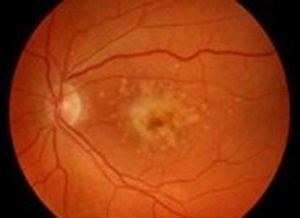Industry News
Algorithm Breakthrough In Diagnosis of Geographic Atrophy
 A team led by Dr Konstantinos Balaskas at UK's Moorfields Eye Hospital Ophthalmic Reading Centre and Clinical A.I. hub has developed a fully automated, deep-learning algorithm that can detect and quantify geographic atrophy using standard eye scans.
A team led by Dr Konstantinos Balaskas at UK's Moorfields Eye Hospital Ophthalmic Reading Centre and Clinical A.I. hub has developed a fully automated, deep-learning algorithm that can detect and quantify geographic atrophy using standard eye scans.
Geographic Atrophy (GA) is a severe irreversible form of age-related macular degeneration (AMD) affecting over 5 million people globally including 22% of people aged over 90. Although difficult to detect in its early stages, it can eventually lead to severe vision loss and blindness, and there is currently no effective treatment. With research into ground-breaking new treatments for GA showing great promise, the newly developed algorithm helps pave the way for their effective use for patient benefit.
However, trials into therapies for geographic atrophy are showing promise and results from Phase 3 trials by Apellis, using a breakthrough treatment called APL-2, which is administered intravitrealy, are due to be released soon. Further testing and the eventual rollout of this therapy could be greatly enhanced by the new algorithm, developed entirely in-house at the NHS in UK by the artificial intelligence (A.I.) team at Moorfields.
The reading centre at Moorfields Eye Hospital NHS Foundation Trust is a state-of-the-art image grading centre for clinical trials and diagnostics in ophthalmology and is the informatics hub of Moorfields, analysing data in order to gain clinical insights.
Currently, examining the many segments of a scan to determine the precise nature of the GA is time-consuming (up to an hour per eye) and prone to human error and variability. In order to develop successful treatments, it is vital for researchers and clinicians to be able to assess precisely how GA manifests itself in the individual eye. The Moorfields team set out to train an algorithm using carefully graded scans from Apellis Pharmaceuticals’ FILLY study so that it could learn to recognise the early signs, precise location and progression of GA automatically.
The newly developed algorithm consists of separate models looking at different aspects of Geographic Atrophy, one is predicting disease progression and the other is determining specific features of the disease. It was developed using 5049 individual segments taken from 984 OCT scans of 200 patients. The scans were part of the FILLY study into a novel treatment for GA and taken from patients based in the USA, Australia and New Zealand. The results were validated using 884 manually graded segments from 192 OCT scans, collected as part of routine patient assessment from 110 patients at Moorfields.
Konstantinos Balaskas, Director of the Reading Centre and Clinical Trials and Digital Eye Health Lead at Moorfields Ophthalmic Reading Centre, said: “At the Moorfields Reading Centre and Clinical A.I. Hub, we are working to pave the way for the safe and user-centric deployment of clinical A.I. for the benefit of patients and healthcare systems. I am particularly proud of our team of brilliant A.I. software engineers who developed a state-of-the-art deep-learning model to support the care of patients with a severe form of dry AMD, Geographic Atrophy. A particular challenge for the management of GA at-scale is the need to reliably, objectively and rapidly quantify and monitor growth of area of GA on the retina using OCT scans and assess its response to potential treatments. We are the first academic/reading centre to develop an A.I. tool to do this. Critically, we tested our AI system rigorously on a separate dataset from real-life clinical practice to ensure it performs reliably. We hope it is a major step towards an effective treatment pathway for GA, which affects millions of people worldwide and often leads to debilitating sight loss”
The current research builds on Moorfields’ earlier success in the development of A.I. to detect early signs of severe ‘wet’ AMD in patients. Pearse Keane, Consultant Ophthalmologist at Moorfields and Artificial Intelligence Lead at the Reading Centre, commented: “In 2016, Moorfields Eye Hospital initiated a collaboration with DeepMind, leading to the development of a ground-breaking A.I. system for evaluation of sight-threatening macular disease. As a result of this work, Moorfields has developed world-leading expertise in the development and application of A.I. systems for healthcare. This represents the first fruits of this learning; a state-of-the-art A.I. system developed entirely within the NHS, for the assessment of age-related macular degeneration (AMD). Given that a recent study estimated that around a quarter of those aged 60 and over in Europe have the early or intermediate forms of this disease, we believe this work could bring huge patient benefits, both within the UK and globally. Perhaps as importantly, we believe this work presages a new era of A.I.-enabled healthcare, driven by healthcare professionals, and where the NHS can be a world leader.”
The study has been published in The Lancet Digital Health: https://www.thelancet.com/journals/landig/article/PIIS2589-7500(21)00134-5/fulltext



